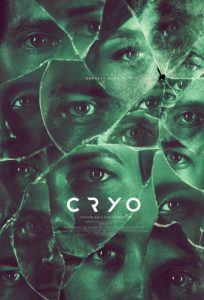CRYO is a psychological thriller, sci-fi whodunnit, which was shot for pennies by a team of mostly BYU students, and then sold to Saban Films for national distribution. It’s my first feature-length film, and is without a doubt the most difficult and rewarding project I’ve ever attempted. It also embodies and reinterprets unique and identifiably Latter-day Saint concepts of heaven and hell.
Prior to my final year of film school, I was contacted by my talented and accomplished friend, Mason D. Davis. If you’ve ever seen a church film, you’ve seen Mason; he often jokes that he’s played every Smith brother except for Don Carlos. I had previously worked with Mason on The Next Door, and found him to be a dedicated, gifted storyteller. When he approached me about directing my first feature film, I jumped at the chance to collaborate, and CRYO was born.
With summer ending and a new school semester quickly approaching, Mason and I pumped out our script. It was a simple enough concept: five scientists wake from cryosleep in a facility with no memory of who they are. There’s nothing particularly original about that—you may have even seen that same setup in other films. However, in trying to give our story its own unique twists and turns, we began to toy with themes that were deeper than a simple whodunnit, and found something we really wanted to say.
After a few drafts of our script, we organized a table read with some of the best screenwriters I could find. They loved our twist, provided great notes, and identified areas where the story wasn’t working. However, they noticed an inherent ideological presence throughout the screenplay—one I had been intentionally trying to avoid on this picture: Mormonism.
In all my previous films, I had explored Latter-day Saint concepts, culture, aesthetics, or iconography. In fact, the year prior to shooting CRYO, I wrote an essay calling for a new wave of more balanced, marketable Latter-day Saint films. (Coincidently, this essay was finally published last year and is currently nominated for an AML Criticism Award). I am in no way embarrassed of (or even subtle about) my Latter-day Saint identity. Rather, I was trying to prove to myself—and, truthfully, probably to others—that I am more than just a “Mormon filmmaker”, and that I can tell stories outside of a Latter-day Saint context when I really want to do so. I didn’t want to be limited to my proclivity for Latter-day Saint Cinema.
However, there it was, implicit to the ideology of the film, even in a gritty genre thriller. Try as I might, there was no getting away from it. I simply could not escape who I was and what I wanted to explore, even subconsciously. Orson Scott Card articulated this best: “Without my even thinking about it, my innate sense of what is true shapes the plots of my stories and subtly preaches the moral values instilled in me by a lifetime as a Latter-day Saint.”
The table readers remarked to Mason and me that our story was only enhanced by those elements, and suggested that we lean into them further. My own points were being thrown back at me! As we implemented clearer references to the days of creation, the veil of forgetfulness, and the devil, the thematic elements of the film were not diluted, but rather grounded by a specific theology. We even added a passage from the Book of Mormon.
The ways in which my Latter-day Saint beliefs are represented in this film are a bit unconventional, to say the least. CRYO earns its PG-13 rating with strong language, on screen violence, and dark implications. At face value, it might even be read as a critique of religious fervor, or the very foundations of God’s salvific plan. However, to me the worst evil is the inverted good. In what I hope is true to the doctrines I espouse, the sweet will be better appreciated by this exploration of the bitter.
After this experience, I will never again second guess weaving Mormonism into my work. While CRYO is by no means a perfect movie, I think those at our table read were right: the film is far more interesting because of its Latter-day Saint undercurrent. I have since continued to articulate my hope that other young Latter-day Saint artists and filmmakers will enjoy the fruits of peppering their religious identity into their work. Don’t waste time worrying (like I did) that you’ll somehow get pigeon holed—there are plenty of stories to tell. I wouldn’t mind if my faith ends up being that distinct flavor which works its way into every movie I ever make.
CRYO is currently screening in three Utah Megaplex theaters, and is available to rent or download on multiple platforms such as AppleTV, Prime Video, Vudu, and Google Play.
Barrett Burgin is a graduate of Brigham Young University and a filmmaker, best known for The Next Door (2016, AML Film Award finalist), Out of the Ground (2017, AML Film Award finalist), Father of Man (2019, AML Film Award), and the science-fiction mystery Cryo (2022). He has written extensively about the intersections between video games, ritual, new media, cinema, the afterlife, immortality, and technology.

